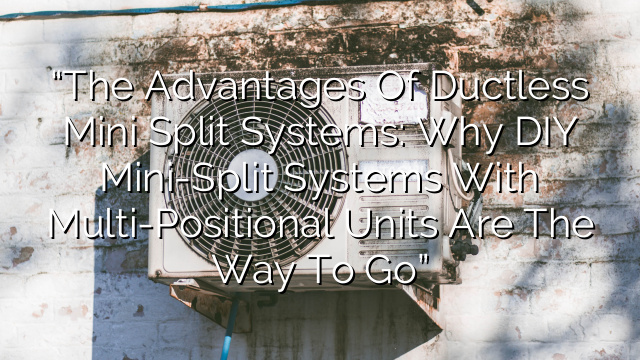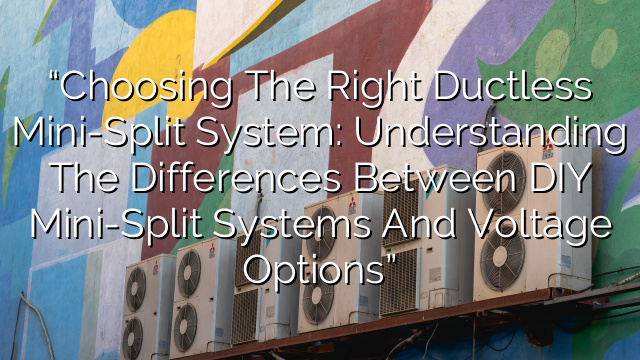Do you want to install a wall-mounted ductless mini-split system yourself? It can be a cost-effective and convenient option for cooling and heating specific rooms in your home. In this blog post, we will discuss the pros and cons of DIY installation for wall-mounted ductless mini-split systems. We will also provide some tips and guidelines to help you make an informed decision.
What is a Wall Mounted Ductless Mini Split System?
A ductless mini-split system is a type of HVAC system that provides heating and cooling without the need for traditional ductwork. As the name suggests, it consists of two main components – an outdoor unit and one or more indoor units. The indoor unit(s) are mounted on the wall and connected to the outdoor unit via refrigerant lines. This system allows you to independently control the temperature in each room, providing a more customized and efficient solution for cooling and heating.
The Pros of DIY Installation
1. Cost Savings: One of the main advantages of DIY installation is the potential for cost savings. By eliminating professional installation costs, you can save a significant amount of money. However, it is important to note that DIY installation may void the warranty of some manufacturers, so be sure to check the terms and conditions before proceeding.
2. Flexibility: DIY installation gives you the flexibility to choose the location of the indoor unit(s) based on your specific needs. You can install them in the rooms where you spend the most time, maximizing comfort and energy efficiency.
3. Learning Experience: Installing a wall-mounted ductless mini-split system yourself can be a valuable learning experience. It allows you to gain knowledge about your HVAC system and gives you the confidence to troubleshoot and perform basic maintenance tasks in the future.
The Cons of DIY Installation
1. Complexity: Installing a wall-mounted ductless mini-split system requires technical skills and knowledge about electrical and refrigeration systems. If you are not familiar with these areas, it may be challenging to complete the installation correctly and safely.
2. Time-consuming: DIY installation can be time-consuming, especially if you are not experienced in HVAC installation. It may involve studying manuals, watching instructional videos, and troubleshooting potential issues. It is essential to allot enough time and be prepared for unexpected complications that may arise during the installation process.
3. Risk of Mistakes: DIY installation increases the risk of making mistakes that can lead to system malfunctions, inefficiencies, or even damage to the equipment. Improper installation can also impact the warranty coverage and could end up costing you more in repair or replacement costs in the long run.
Tips for DIY Installation
If you decide to proceed with DIY installation of a wall-mounted ductless mini-split system, consider the following tips:
1. Research: Familiarize yourself with the installation process by reading the manufacturer’s installation manual and watching instructional videos. Research local building codes and permits required for HVAC installation to ensure compliance.
2. Tools and Equipment: Gather all the necessary tools and equipment before starting the installation. This may include a refrigerant manifold gauge set, a vacuum pump, a drill, a pipe cutter, electrical tools, and safety equipment.
3. Safety First: Prioritize safety during the installation process. Ensure that the power supply is turned off before working on electrical connections. Follow proper handling procedures for refrigerant to prevent leaks or injury.
4. Get Assistance: DIY installation can be challenging, especially when handling heavy components or performing complex tasks. Consider seeking assistance from a friend or family member to make the process easier and safer.
FAQs
Q: Do I need a professional license or certification to install a wall-mounted ductless mini-split system myself? It depends on your location and the specific regulations in your area. Some jurisdictions may require a license or certification for HVAC installation. Check with your local authorities to ensure compliance with legal requirements.
Q: Can I install a wall-mounted ductless mini-split system in any room? Yes, you can install indoor units in any room where you want cooling or heating. However, it is essential to consider factors such as the size of the room, the location of windows and doors, and the availability of electrical connections and proper ventilation.
Q: How long does it take to install a wall-mounted ductless mini-split system? The installation time can vary depending on various factors, including the complexity of the installation, your familiarity with HVAC systems, and any unforeseen complications. On average, it may take anywhere from a few hours to a full day to complete the installation.
Q: Can I connect multiple indoor units to one outdoor unit? Yes, one outdoor unit can typically support multiple indoor units. This allows you to cool or heat multiple rooms with a single outdoor unit, providing increased energy efficiency and cost savings.
Q: Is DIY installation of a wall-mounted ductless mini-split system suitable for everyone? No, DIY installation of a wall-mounted ductless mini-split system requires technical skills and knowledge. It is not suitable for individuals without prior experience or familiarity with electrical and refrigeration systems. If you are unsure about your abilities or have concerns about safety, it is best to hire a professional installer.
In conclusion, DIY installation of a wall-mounted ductless mini-split system can offer cost savings, flexibility, and a valuable learning experience. However, it is important to consider the complexity, time commitment, and potential risks associated with this type of installation. Be sure to research and prepare adequately before attempting the installation yourself. If in doubt, it is always recommended to seek professional HVAC installation services.














